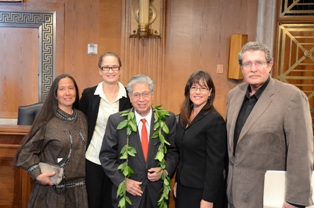Washington D.C. –
U.S. Senator Daniel K. Akaka (D-Hawaii), Chairman of the Senate Committee on Indian Affairs, held an oversight hearing today examining the current trends and achievements in Native language and culture-based education. The hearing, In Our Way: Expanding the Success of Native Language and Culture-Based Education, highlighted efforts to meet student and Native community needs through education and addressed recommendations for the reauthorization of the Elementary and Secondary Education Act.
 “Teaching young people through their cultures and traditions helps them to learn well, because culture and traditions are the roots of their lives,” said Chairman Daniel K. Akaka at the hearing today. “To force them to oki, to cut, that root off interferes with the natural growth and progress of our Native people. The hearing demonstrated that encouraging students to grow from their cultural roots improves their academic performance. I am committed to working with my colleagues to advance Native language and culture-based education.”
“Teaching young people through their cultures and traditions helps them to learn well, because culture and traditions are the roots of their lives,” said Chairman Daniel K. Akaka at the hearing today. “To force them to oki, to cut, that root off interferes with the natural growth and progress of our Native people. The hearing demonstrated that encouraging students to grow from their cultural roots improves their academic performance. I am committed to working with my colleagues to advance Native language and culture-based education.”
Two witness panels explored the importance of Native language and culture-based education, offering first-hand testimony about the impacts of these programs on overall student achievement. Panelists also described the barriers, needs, and strategies that could be employed to expand success in using Native language and culture-based curricula.
“We have made great progress over the past nearly 30 years, but there is still a lot of work to do,” said Namaka Rawlins, Outreach Specialist for ‘Aha Punana Leo. “We share what we have learned through technical assistance to other Native American tribes. Not all are in a position to do full immersion right now, but all are learning small steps that can be taken to reclaim their languages.”
“The involvement of the tribe in the schools has resulted in an integration of our tribal language, culture and priorities directly into the curriculum,” said Kevin Shendo, Education Director for the Pueblo of Jemez. “We are, in essence, developing an indigenous pedagogy that best meets the academic needs of our student population.”
“The achievement and education progress data of Native American students in school programs without culturally based efforts indicate that current education strategies are not efficacious for many,” said Dr. David Beaulieu, Professor at the University of Wisconsin-Milwaukee. “Cultural compatibility holds that the more human interactions in the school and classroom are like those of a student’s culture, the better the goals of the school will be reached.”
“It was time for change. It was time to begin building the bridge of trust between school and community, so the district went to the people and the people spoke,” says Jana Harcharek, Director of Inupiaq Education of the North Slope Borough School District in Alaska. “The people said that they want their children’s schools to reflect who they are. Their children should no longer have to leave their identities outside when they walk into their schools. They should learn to think like Inupiat because they are Inupiat.”
According to the National Indian Education Association, approximately 300 distinct languages were once spoken in what is now the United States. Today, all of the less than 175 Native languages that survive are seriously endangered. In Hawaii, a number of Hawaiian language-immersion schools have flourished in recent years, with graduates attending top universities. Native language and culture-based schools in other states across the U.S. are accomplishing similar feats.
Contact: Jesse Broder Van Dyke
Contact Phone: 202-224-7045
Contact E-mail: jesse_brodervandyke@akaka.senate.gov
